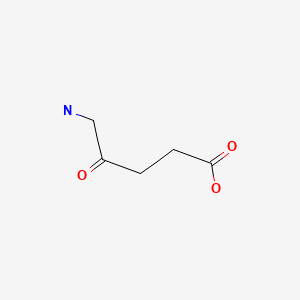CASRN: 106-60-5

Drug Levels and Effects
Summary of Use during Lactation
No information is available on the use of oral aminolevulinic acid during breastfeeding. To minimize exposure of the infant, breastfeeding can be withheld for 24 hours after an oral dose. Breastfeeding is not expected to result in exposure of the child to topical aminolevulinic acid due to negligible systemic absorption. Aminolevulinic acid-induced photodynamic therapy has been used successfully to treat various skin lesions of the nipple. This treatment appeared to preserve nipple anatomy for breastfeeding.[1-3]
Drug Levels
Maternal Levels. Relevant published information was not found as of the revision date.
Infant Levels. Relevant published information was not found as of the revision date.
Effects in Breastfed Infants
Relevant published information was not found as of the revision date.
Effects on Lactation and Breastmilk
Relevant published information was not found as of the revision date.
References
- 1.
- Zhou X, Zheng M, Zou Y, et al. 5-Aminolevulinic acid induced photodynamic therapy (ALA-PDT) for erosive adenomatosis of the nipple: A case report. Photodiagnosis Photodyn Ther. 2021;35:102387. [PubMed: 34107318]
- 2.
- Xu S, Wang X, Xu W, et al. Evaluation of photodynamic therapy of skin cancers with partial differential alpha-aminolevulinic acid. Chin Med J (Engl). 2002;115:1141–5. [PubMed: 12215278]
- 3.
- Ye E, Wang W, Wu Y, et al. Cryotherapy combined with photodynamic therapy for successful treatment of condyloma acuminatum in special sites such as the nipple and the nasal vestibule: A series of two case reports. Photodiagnosis Photodyn Ther 2022:102930. [PubMed: 35644347]
Substance Identification
Substance Name
Aminolevulinic Acid
CAS Registry Number
106-60-5
Drug Class
Breast Feeding
Lactation
Milk, Human
Dermatologic Agents
Photosensitizing Agents
Disclaimer: Information presented in this database is not meant as a substitute for professional judgment. You should consult your healthcare provider for breastfeeding advice related to your particular situation. The U.S. government does not warrant or assume any liability or responsibility for the accuracy or completeness of the information on this Site.
Publication Details
Publication History
Last Revision: September 19, 2022.
Copyright
Attribution Statement: LactMed is a registered trademark of the U.S. Department of Health and Human Services.
Publisher
National Institute of Child Health and Human Development, Bethesda (MD)
NLM Citation
Drugs and Lactation Database (LactMed®) [Internet]. Bethesda (MD): National Institute of Child Health and Human Development; 2006-. Aminolevulinic Acid. [Updated 2022 Sep 19].